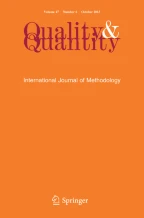Abstract
Mobile commerce systems allow customers to purchase products over the Internet without using a pc. It also creates a new mobile business model and change e-commerce paradigms, having an especially significant effect on the medical and insurance industries. Furthermore, the real estate industry is increasing in the booming market, but tends to become overheated. Thus, some innovative techniques (such as mobile commerce) were adopted by estate agent to enhance their competitive advantage. Consequently, identifying the match between mobile commerce technique and individual performance is a valuable focus of research. In fact, technology acceptance model (TAM) is a well-known theory regarding the adoption of information technology (IT), but ignores the focus on evaluating IT; meanwhile, the task-technology fit (TTF) model takes a directly rational approach by assuming that users choose to use IT that provides benefits but does not consider about users’ beliefs and attitude towards IT. Therefore, this study examined an integrated model of TAM and TTF that provided additional explanatory power via structural equation modeling. Analytical results confirm that the integrated model provides greater explanatory power than either TAM or TTF alone. Furthermore, several practical implications and recommendations are also discussed below.
Similar content being viewed by others
References
Arning K., Ziefle M.: Understanding age difference in PDA acceptance and performance. Comput. Human Behav. 23(6), 2904–2927 (2007)
Bagozzi R.P.: A field investigation of causal relations among cognitions, affect, intentions, and behaviour. J. Mark. Res. 19(4), 562–583 (1982)
Bagozzi R.P., Heatherton T.F.: A general approach to representing multifaceted personality constructs: application to self esteem. Struct. Equ. Model. A Multidiscip. J. 1(1), 35–67 (1994)
Byrne B.: Structural Equation Modeling with LISREL, PRELIS, and SIMPLIS: Basic Applications and Programs. Lawrence Erlbaum, Mahwah (1998)
Clarke I. III: Emerging value propositions for M-commerce. J. Bus. Strateg. 18, 133–148 (2001)
Coursaris C., Hassanein K., Head M.: M-commerce in Canada: an interaction framework for wireless privacy. Can. J. Adm. Sci. 20(1), 54–73 (2003)
Cudeck R., Browne M.W.: Cross-validation of covariance structures. Multivar. Behav. Res. 18(4), 147–167 (1983)
Davis F.D.: Perceived usefulness, perceived ease of use, and user acceptance of information technology. MIS Q. 13(3), 319–342 (1989)
DeVellis R.F.: Scale Development: Theory and Applications (Applied Social Research Methods Series. Sage Publications, Inc., Newbury Park (1991)
Dishaw M.T., Strong D.M.: Extending the technology acceptance model with task—technology fit constructs. Inf. Manag. 36, 9–21 (1999)
Fishbein M.A., Ajzen I.: Belief, Attitude, Intention and Behavior: An Introduction to Theory and Research. Addison-Wesley, Reading (1975)
Fornell C., Larcker D.F.: Structural equation models with unobserved variables and measurement errors. J. Mark. Res. 18(1), 38–50 (1981)
Gefen D., Straub D.W.: Gender differences in perception and adoption of email: an extension to the technology acceptance model. MIS Q. 21(4), 389–400 (1997)
Goodhue D.L.: Understanding user evaluations of information systems. Manag. Sci. 41(12), 1827–1844 (1995)
Goodhue D.L., Thompson R.L.: Task-technology fit and individual performance. MIS Q. 19(2), 213–236 (1995)
Goodhue D.L., Klein B.D., March S.T.: User evaluations of IS as surrogates for objective performance. Inf. Manag. 38, 87–101 (2000)
Hair J.F., Anderson R.E., Tatham R.L., Black W.C.: Multivariate Data Analysis. Prentice-Hall, Englewood Cliffs (1995)
Igbaria M., Zinatelli N., Cragg P., Cavaye A.M.: Personal computing acceptance factors in small firms: a structural equation model. MIS Q. 21(3), 279–305 (1997)
Ives B., Learmonth G.P.: The information system as a competitive weapon. Commun. ACM 27(12), 1193–1201 (1984)
Jackson C.M., Chow S., Leitch R.A.: Toward an understanding of the behavioral intention to use an information. Decis. Sci. 28(2), 357–389 (1997)
Joreskog K.G., Sorbom D.: LISREL 8: Structural Equations Modeling with the SIMPLES Command Language. Scientific Software, International, Chicago (1993)
Kippenberger T.: Fasten your seatbelts. Antidote 5(1), 38–39 (2000)
Kumar S., Stokkeland J.: Evolution of GPS technology and its subsequent use in commercial markets. Int. J. Mobile Commun. 1(1/2), 180–193 (2003)
Lee C.C., Cheng H.K., Cheng H.H.: An empirical study of mobile commerce in insurance industry: task technology fit and individual differences. Decis. Support Syst. 43(1), 95–110 (2007)
Liaw S.S., Hatala M., Huang H.M.: Investigating acceptance toward mobile learning to assist individual knowledge management: based on activity theory approach. Comput. Educ. 54(2), 446–454 (2010)
McCreadie M., Rice R.: Trends in analyzing access to information, Part I: cross-disciplinary conceptualizations of access. Inf. Process. Manag. 35(1), 45–76 (1999)
NCC.: http://www.ncc.gov.tw/chinese/files/09032/1134_9886_090323_1.xls (2009). Accessed 5 Apr 2009
Ngai E.W.T., Gunasekaran A.: A review for mobile commerce research and applications. Decis. Support Syst. 43(1), 3–15 (2007)
Nunnally J.C.: Psychometric Theory. McGraw-Hill, New York (1967)
Pagani M.: Determinants of adoption of third generation mobile multimedia services. J. Interact. Mark. 18(3), 46–59 (2004)
Pagani M.: Determinants of adoption of high speed data services in the business market: evidence for a combined technology acceptance model with task technology fit model. Inf. Manag. 43(7), 847–860 (2006)
Pentland, B.T.: Use and productivity in personal computers: an empirical test. Proceedings of the tenth international conference on information systems, Boston, pp. 211–222 (1989)
Rose G., Khoo H., Straub D.W.: Current technological impediments to business-to-consumer electronic commerce. Commun. AIS 1(16), 1–73 (1999)
Shih, Y.Y., Huang, S.S.: Exploring the critical success factors of mobile commerce via qualitative method—in case of insurance industry. The international conference on information technology—new generations (ITNG 2009), Las Vegas, pp. 27–29 (2009)
Steiger J.: Structural model evaluation and modification: an interval estimation approach. Multivar. Behav. Res. 25(2), 173–180 (1990)
Taylor S., Todd P.: Assessing IT usage: the role of prior experience. MIS Q. 19(4), 561–570 (1995)
Vessey I.: Cognitive Fit: a theory-based analysis of the graphs versus tables literature. Decis. Sci. 22(2), 219–240 (1991)
Vogt H., Gartner F.C., Pagnia H.: Supporting fair exchange in mobile environments. Mobile Netw. Appl. 8(2), 127–136 (2003)
Author information
Authors and Affiliations
Corresponding author
Rights and permissions
About this article
Cite this article
Shih, YY., Chen, CY. The study of behavioral intention for mobile commerce: via integrated model of TAM and TTF. Qual Quant 47, 1009–1020 (2013). https://doi.org/10.1007/s11135-011-9579-x
Published:
Issue Date:
DOI: https://doi.org/10.1007/s11135-011-9579-x
